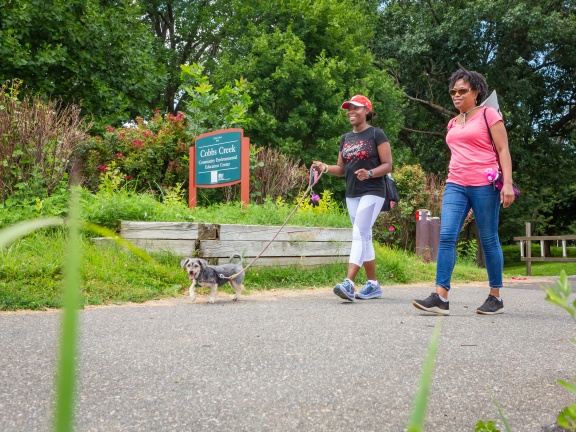
Background
Trails offer wide-ranging benefits to communities, supporting health, active transportation, and economic development. Trails connect people to the outdoors and each other, enhancing physical and mental health, strengthening communities, and improving overall quality of life. In addition to their recreational value, trails function as vital infrastructure for non-motorized transportation, providing safe and sustainable travel options. They also contribute to local economies, making neighborhoods more attractive places to live and work.
Greater Philadelphia is home to the Circuit Trails, a regional network of hundreds of miles of multi-use trails that continues to grow each year. Since its launch in 2012, the Circuit Trails has become one of the largest trail systems of its kind in the country. With more than 850 miles planned and about half already complete, the network is an essential public asset for the region.
Building trails is only part of the work; trails also need to be maintained, stewarded, and sustained for long-term use. And, critically, they should be safe, accessible, welcoming, and responsive to the needs of all people – especially communities that are underserved or populations that have historically found trails to be unwelcoming or inaccessible.
Opportunity Overview
The Foundation seeks to support efforts that will help to expand the Circuit Trails network by 75 miles in the next 10 years.
The Foundation recognizes that there are many different tactics or approaches that could be used to advance the objective stated above. However, in this RFP we will not be considering proposals for acquisition, planning, design, engineering, or construction of a trail segment. Projects in those categories will be funded through a different vehicle. All other proposals that meet the criteria described below are encouraged.
Organizations that propose projects in partnership with other applicants will be considered on their individual merits. However, the Foundation recognizes that making significant progress on the objective is difficult and encourages organizations to include partnerships that leverage complementary strengths, resources, and expertise to reach proposed goals.
To date, a key driver of the progress made on developing the Circuit Trails has been the Circuit Trails Coalition, a collaborative of more than 50 nonprofit organizations and government agencies committed to the equitable development and use of the trail network. The Coalition has established a 5-year strategic plan to guide its efforts and ensure that the system serves and benefits all of the communities it connects. This plan identifies “Priority Projects” where trail development can provide the most benefit to people, based on population density; race/ethnicity; income; access to transportation, employment, and natural assets; and other factors. We are especially eager to see proposals that will advance these Priority Projects.
In general, proposed projects may focus on advocacy, technical assistance, outreach, community engagement, communications, stewardship, programming, or other ways to expand the Circuit Trails network. Examples of eligible project types include, but are not limited to:
- advocating for Circuit Trails development or maintenance to be prioritized at the state, regional, or local level, including growing grassroots support for “Priority Projects” in the Circuit Trails Coalition’s strategic plan;
- providing technical assistance to an entity seeking to construct a Circuit Trail by 2035;
- providing services that directly support the Circuit Trails Coalition’s work to accelerate equitable trail development, such as applied research, database management, or other services;
- conducting marketing and communications that elevates the importance of the Circuit Trails among influential constituencies;
- supporting trail stewardship or maintenance to grow community or city support for specific additional trails; and
- providing programs that demonstrate a strong potential to advance a specific trail, such as guided walks to or along a trail “gap,” or a youth development initiative integrated with advocacy training. (Applicants seeking support for programming that is not linked to a specific trail development opportunity should consider applying to the next William Penn Foundation Outdoor Programming RFP.)
While this RFP invites proposals that support the user experience, as these examples indicate, the proposals should articulate a clear connection between the proposed activities and the Foundation’s objective of adding 75 miles to the Circuit Trails network by 2035.
In describing the proposed work, all submitted proposals should, as applicable:
- identify the trail segment(s) that the proposed work is intended to advance;
- identify the funding or policy opportunities the proposed work is intended to advance;
- articulate how the proposed work seeks to advance or complement specific element(s) of the Circuit Trails Coalition’s strategic plan;
- project (to the maximum extent possible) the number of miles of trails that will be developed because of the work, and the anticipated timeframe.
The following types of projects will not be funded through this RFP:
- right-of-way acquisition, planning, design, engineering, or construction of a trail segment;
- planning, design, engineering, or construction of a community asset adjacent to a trail (e.g., boat launch, benches, etc.).
- any project that does not make a clear contribution to expanding the number of miles in the Circuit Trails network.
We are requesting proposals for up to three years of funding. After reviewing proposals, WPF will conduct site visits and gather additional information from a limited number of organizations. WPF has $6 million available to advance this objective through this RFP.
WPF values diverse approaches from various organizations and communities to address the objective, and we aim to attract and fund a range of projects – including those led by smaller organizations and by people who have historically faced discrimination or exclusion. There is no minimum or maximum amount of funding that projects may request. The grant amount requested should be commensurate with the contribution that the project will make to the overall objective.
Full Request for Proposals (RFP) and Application
Download the full RFP packet for more information about this opportunity including eligibility, review criteria, learning and insights, budget, and link to an application template.
All applications must be submitted through the Grants Portal.
Webinar
An optional informational webinar took place on June 24: